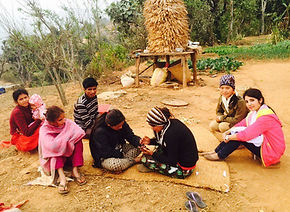Mission,Achievement
Mission
Our aim is to develop a disaster risk reduction method to ensure health security in disaster prone communities. Collaborating with local Nepali nurses, named as EpiNurses (Epidemiology+Nurse), who conduct a participatory monitoring by using ICT toolkit, we work toward protection and promotion of health and safety in shelters and communities.

Public Health Center as Local Hub
At minimum, communication and regular social capital evaluation by EpiNurse could be undertaken here. For this operation, good collaboration with government is also required for better coordination of the interoperability of rapid assessment with other data services for further cooperation and close partnerships with local volunteer.Public Health Center would be used as the local hab of this project.
This local hub also be expected to create ripple effects. For example:
1. Monitors can find out the challenges and issues faced by communities, civil societies and underprivileged from their point of view. This will help to clarify and find the solutions of the problem;
2. Together, people can find the solutions of the problem through implementation of innovative and modern business approach;
3. Continuity and development of the business will help to achieve economic outcomes which will have economic and employment effect.



Ensuring Health as a Key Outcome of DRR
Assessment toolkit consists of simple software with paper and smartphone application, and it is in layman’s terms for local nurses who are main users. The items in this toolkit include living environment assessment and item of Surveillance in Post Extreme Emergencies and Disasters (SPEED), which was conceptualized to provide real time health information reporting after a disaster developed by WHO/WPRO, and a surveillance item, which have been used by Ministry of Health. In this way, the toolkit was developed to create an Application Programming Interface (API) for data collection and sharing with other health sectors and national surveillance.

Participatory Monitoring
A community participatory approach to disaster risk requires greater human behavioral consideration on how people interpret and live with risks, and how individual perception, knowledge, attitude contribute to putting them in vulnerable situations. Geospatial information technologies could be an innovative approach for community nursing to very early case finding in more efficient manners. Among the technologies, smartphones offer breakthroughs of analyzing local community with its characteristics and individual behaviors relevant to the community health.

Case Station for Translational Research
Emergency health situations often occur as a consequence of a primary disaster of great magnitude due to its impact on the living environment. The relationship between the occurrence of a disaster and an outbreak of communicable diseases is reported to be associated with the size and characteristics of the displaced populations. The lack of infrastructure and resources, inexistence of disaster preparedness programs are among factors that contribute to increased risks of epidemics following a humanitarian crisis. Critical attention should be paid to hygiene control in shelters to maintain minimum health safety level. In this context, reducing risks involves changed behavior and lifestyle during a temporary settlement period after disaster.
In local communities, nurses collect information about and mitigate communicable disease risks. Nurses may manage community’s health environment as well as hospital wards. They can play a vital role in restoration of public health under disaster condition (water, sanitation, food, and shelter) and in identification of high risk and vulnerable population including unique needs of family in disaster.

Beneficiaries
Target beneficiaries are people in communities and government agencies. The proposed project is innovative in utilization of ICT abilities in the field of health security. Continuing monitoring and reporting via cell phone can prodvide invaluable health information in times of crisis. The advisers and colleagues from other countries can complement the knowledge and skills to assess and enhance health, as well as technological applications covered for and adopted specifically to Nepal situation. The project proposes health risk surveillance, an essential part of disaster planning and management, through planned response. The proposed model has practical applicability; it may be embedded in risk reduction plans both in times of routine and during emergencies. Such planning can be useful for preparing towards future potential health risks, and global disaster response for large earthquakes.





